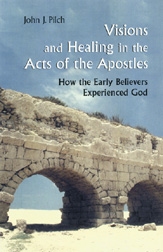
|
Posted September 28, 2004
Book: Visions and Healing in the Acts of the Apostles: How the Early Believers Experienced God Author: John J. Pilch Liturgical Press, Collegeville, MN, pp. 194 Excerpt from Jacket:
Excerpt from Book: The disciples proceeded southeast from Antioch to the region of Lycaonia, specifically to three neighboring cities: Iconium, Lystra, and Derbe. In Iconium they preached boldly and their words were confirmed by mighty deeds. The Lord granted “signs and wonders to occur through their hands.” Typically, response was divided. Some were favorable, others determined to attack and stone them causing the two to flee. In Lystra, Paul healed a man who was a cripple from birth. The healing is very similar to that of Peter in Acts 3. Both sick men are described by the same phrase: “a man crippled from birth,” “a crippled man, lame from birth. Peter and Paul “looked intently (stare, gaze)” at the men before raising them. In other words, both healers entered a trance, no doubt a healing trance, one of the categories identified by Dr. Goodman. Both healed men confirmed their improved condition by leaping, walking, jumping/jumping up and walking. Both healings are effected through “faith.” Finally, both healing events took place near Temple gates. Scholars identify a basic “literary” form in reporting such healing stories. The form includes an exposition, the healer’s word and gesture, demonstration or proof of the healing, and effect on the bystanders. The form is evident in Peter’s healing and in similar stories. Some think that the story about Paul may be a repetition or transferal of Peter’s story to enhance Paul’s status. This interpretation is certainly possible and common on a literary level. Yet as we already noted about literary forms relative to the report of Paul’s call and commission by God, the texts we read report a predictable Mediterranean cultural behavior pattern. Culture dictates how one should behave in a given situation; in this case, how a holy man (Peter, Paul) ought to behave in a healing situation. Their behaviors are not idiosyncratic. They are part of a rite. The importance of ritual cannot be underestimated. If it is not performed precisely, the desired results, in this case healing, might not happen. Dr. Goodman considers ritual the bridge over which beings from the realm of God enter into our ordinary world. Literary form particularly in healing stories seems most certainly to reflect a defined healing ritual rite. Strelan has noted some key elements in this report which strongly correlate with trance experiences, particularly the stare and the loud voice. Recall what we mentioned above concerning the stare as an indication that a person may be in trance. Here Paul, a holy man, “filled with holy Spirit” and empowered to heal by the “living God”, fell into trance (“looked intently” at the lame man). In this state of consciousness, he gained an intuition into the crippled man’s condition: “he had the faith to be healed” (literally “saved” or “rescued”) and Paul restored him to wholeness. Strelan also correctly suggests that Paul’s physical condition, e.g., his breathing (strong breathing, or sighing) may have been altered. The magical papyri often recommend deep breathing, sighing, groaning, hissing, and other respiratory noises for the one who would work magic. Yet another significant element that Strelan points out in this story is the identification of Paul as Hermes, a messenger with wings on his feet. According the Hippocrates, “opposites cure opposites.” A healer must have the proper spirit to heal the spirit of the cripple and the spirit causing the cripple’s condition. Moreover, the ancients following Aristotle believed it was the soul that felt pain. Paul gazed into the soul of this man, saw his faith (=loyalty to the healer) to be healed, and made him well again. Finally, the loud voice characterizes trances of holy men across cultures, specifically a change of voice or increase in tone and volume. Indeed, one ecstatic trance posture identified by Goodman, The Singing Shaman, begins with sound that changes during the trance. Dr. Goodman’s research on glossolalia shows that shouting is typical in glossolalia experiences. It is therefore plausible to suspect that a trance is occurring in instances where a loud voice is mentioned. For instance, Luke mentions a loud voice when describing those offering praise to God. At hearing the voice of Mary, Elizabeth was “filled with the holy Spirit” and exclaimed her sentiments “with a loud cry.” This is an ecstatic cry, and Luke appropriately links Spirit-possession with the loud cry. Table of Contents: Chapter 1 Acts 1 - 2 The Journey Begins Communal Religious Trance Experiences Chapter 2 Acts 3 - 5 Temple Tours: God Acts in the Temple and a Private Home Chapter 3 Acts 6 - 12 The Journey beyond Jerusalem: Individuals and Communal ASCs Chapter 4 Acts 13:1 - 21:36 Journeys into Non-Israelite Territory Chapter 5 Acts 21:37 - 28:15 Prisoner’s Progress Acts 28:16 - 31 The Journey Concludes Conclusion |
|
